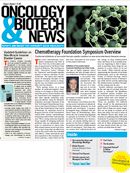March 2008
The Academy delivers the latest news on biotech and oncoloy research, providing a link between the clinical world of cancer care and the university researchers who are pushing the envelope of knowledge and discovery.
UNIVERSITY OF TEXAS SOUTHWESTERN MEDICAL CENTER
Protein-Mimetic Kills Lung Cancer Cells
A synthetic molecule that mimics a suicide-triggering protein called Smac can cause human lung cancer tumors grown in mice to regress or disappear. The new findings, which appear in the November issue of Cancer Cell, suggest that the compound could one day be used as a targeted therapy for lung and other cancers.
Howard Hughes investigator Xiaodong Wang, PhD, professor of biochemistry at the University of Texas Southwestern Medical Center in Dallas, Texas who led the study, first announced the discovery of the cell protein Smac in 2000. Smac, which is released by mitochondria, plays a role in the normal apoptosis of cells, a process that is turned off in tumor cells. Dr. Wang and his colleagues developed molecules that mimicked Smac and could enter cells and trigger apoptosis without requiring the mitochondria to release Smac. The mimetic, however, only killed cancer cells when introduced together with another molecule called Tumor Necrosis Factor-α or TNF-α.
In the new study, Dr. Wang and his colleagues found that some human non—small cell lung cancer cell lines reacted to the Smac mimic without requiring TNF-α. Of the 50 non–small cell lung cancer cell lines the researchers tested, 22% were sensitive to the Smac mimic alone. These sensitive cell lines, the researchers found, produced their own TNF-α.
This is paradoxical, said Dr. Wang, because TNF-a signaling is part of a complex pathway that gives cancer cells a survival signal. “Thus, in these cancer cell lines, the TNF-α survival advantage turns out to be a fatal flaw, because the same pathway can be switched to apoptosis by Smac mimetics,” said Dr. Wang. He added that in the future, Smac mimics could be used to treat some cancers and that the presence of TNF-α could serve as a marker to tell doctors which tumors would respond to the Smac mimetic alone.
DUKE UNIVERSITY MEDICAL CENTER
Obesity Decreases Effectiveness of PSA Test
Researchers at the Duke University Medical Center have found that high blood volumes linked to obesity can dilute levels of Prostate Specific Antigen (PSA). The results indicate that doctors need to adjust the current PSA test when screening obese patients for prostate cancer.
Oncology & Biotech News
“Physicians need to take increased body weight into consideration when interpreting PSA results in obese men,” Lionel Banez, MD, of Duke University Medical Center in Durham, North Carolina, told . “Failure to do so may lead to a large number of missed cancers.”
Journal of the American Medical Association
In a November 21 paper, Dr. Banez and his colleagues state that higher body mass index (BMI) in men was associated with higher blood plasma volume, which in turn means lower PSA levels.
The researchers looked at more than 13,000 men who had undergone radical prostectomy between 1988 and 2006. They found that men with a BMI of at least 35 had 21%—23% larger plasma volumes than men with normal weight. After adjusting for clinicopathological variables, men with a BMI of 35 or greater had 11%–21% lower PSA concentrations as compared with normalweight men. “It is reasonable then, when caring for obese patients, to lower the threshold or assign a lower PSA cut-off point which prompts a diagnostic prostate biopsy,” said Dr. Banez.
Several other studies have shown that obese men have lower PSA concentrations than nonobese men, but there have been two hypotheses to explain this observation. One was that obese men make less PSA because of lower levels of testosterone, which is related to PSA production. The other was that obese men create more blood to support their size, which effectively dilutes PSA levels. The purpose of the new study was to determine which of two hypotheses is true and the latter is very clearly the answer, said Alan Partin, MD, chief of the Department of Urology at Johns Hopkins’ Brady Urological Institute and one of the study’s authors.
Stephen Freedland, MD, professor of Urology at Duke University, said that many new tests for cancer and other diseases that are being developed currently rely on the concentrations of disease markers, similar to PSA tests. “For these other tests just starting down the development pipeline, we need to think about the actual total amount of a biological marker rather than concentration,” he said.
Rhode Island Hospital
Microwave Ablation Safe for Lung Cancer
In a new study, researchers at Rhode Island Hospital have shown that microwave energy can be safely used to shrink or eliminate malignant lung tumors. The researchers presented their results on microwave ablation at the Radiological Society of North America meeting. Rhode Island Hospital in Providence is one of 10 facilities in the country that offer microwave ablation—physicians at the hospital were the first in the United States to treat cancer with the technique.
During microwave ablation, radiologists use computed tomography—imaging guidance to place a thin microwave electrode into the tumor. A microwave generator emits electromagnetic waves that excite water molecules in the tumor tissue, creating intense heat and friction that destroys the tumor.
Damian Dupuy, MD, director of tumor ablation at Rhode Island Hospital, and his colleagues treated 50 patients with 82 lung tumors 66 times. Each of the lung tumors was ablated for seven to ten minutes. The radiologists followed up with the patients at one, three, and six months with CT scans and PET imaging.
The researchers found that the 13 patients who had the largest tumors had residual disease at the microwave ablation site. Eleven patients had recurrent disease. The survival rates regardless of tumor size or the presence of residual disease were as follows: one-year survival of about 83%, two-year survival of about 73%, and three-year survival of about 61%.
These initial results look promising, according to the researchers. “Microwave ablation offers patients with inoperable lung cancer or those who cannot benefit from more traditional therapies with a much-needed minimally invasive treatment option,” said Dr. Dupuy.
UNIVERSITY OF CAMBRIDGE
Ultrasensitive MRI Technique Shows Early-Stage Chemotherapy Efficacy
Nature Medicine
A technique that boosts the sensitivity of MRI by more than 10,000 could show doctors how a patient’s tumors are likely to respond within days of starting treatment, according to an online paper by researchers at Cancer Research UK.
The researchers, led by Kevin Brindle, PhD, a biochemistry professor at the University of Cambridge, used a hypersensitive scanning technique developed by GE Healthcare to image mice with lymphoma that were being treated with chemotherapy. The researchers could see tumor cells being killed, confirming that the drug was working. “If this technique proved effective in cancer patients, it would provide a vital early indication of response to treatment,” Dr. Brindle said. “This is important because the sooner a doctor identifies that a drug isn’t working as well as hoped, the sooner an alternative can be prescribed.”
The technique, called hyperpolarized MRI, involves increasing the polarization of the atoms in chemicals—lining up the magnetic fields of the atoms’ nuclei in the same direction— so that they emit a stronger resonance signal. The researchers hyperpolarized a compound called pyruvate, which cancer cells use to make energy. They do this by cooling the chemical to absolute zero (-273°C).
Once the chemical is hyperpolarized, the researchers dissolve it in superheated water. Then they give the chemical to the mice and then quickly scan the animals before the atoms in the chemical return to their normal state. The MRI scans are extremely sensitive in detecting the hyperpolarized pyruvate, and show slight decreases in the chemical’s uptake by the tumor cells, showing that the cells are dying.
ABRAMSON CANCER CENTER, UNIVERSITY OF PENNSYLVANIA, PHILADELPHIA and RUSH UNIVERSITY MEDICAL CENTER, CHICAGO
Revlimid Improves Survival in Multiple Myeloma Patients
Two large, international clinical trials, one from the United States and one from Europe, have shown that a combination of the oral cancer drug Revlimid (lenalidomide) and the steroid dexamethasone leads to increased survival in patients with multiple myeloma. The drug combination increased median survival to three years—the longest known for this patient group—and patients significantly improved on all measures where other treatments had failed.
New England Journal of Medicine
Researchers from the University of Pennsylvania’s Abramson Cancer Center in Philadelphia, and the Rush University Medical Center in Chicago, Illinois took part in the U.S. study, results of which were published in the November 21 .
Stephanie Gregory, MD, director of the section of Hematology at the Rush University Medical Center, pointed to the need for finding therapies for multiple myeloma. “Statistics show the number of diagnoses is increasing in the United States where most cancers are decreasing, and myeloma is being found in increasingly younger patients,” she said. “These trends give us some urgency in having potent treatments to fight this disease.”
Revlimid, first in the class of drugs known as immunomodulatory drugs, works by attacking both cancer cell and the microenvironment in which it lives in the bone marrow. It stops the cells’ ability to stick to the wall of tissues where they could grow and also inhibits angiogenesis— the growth of blood vessels that feed tumors.
In the studies, a total of 705 patients were given either Revlimid and dexamethasone or placebo plus dexamethasone. The patients had previously been heavily treated for multiple myeloma, and many had failed three or more rounds of chemotherapy and/or radiation therapy. More than half of the patients had undergone stem-cell transplantation.
“The last five to ten years have been the most wonderful time to be a physician treating multiple myeloma, thanks to advances like lenalidomide,” said Edward Stadtmauer, MD, director of the Abramson Cancer Center Bone Marrow and Stem Cell Transplant Program. “Twenty, thirty years ago, there wasn’t much we could do for these patients. We couldn’t really treat the disease effectively so we tried to treat the symptoms with only two or three types of chemotherapy and radiation, which have their own negative side effects. Now, we have this new, highly effective class of drugs with very low side effects.”
As a result of the findings, the official physician guidelines for multiple myeloma were recently updated to add Revlimid as an initial treatment. “Myeloma has been a difficult disease to cure, but with novel therapies we are developing effective, long-term treatments by using multiple drugs in sequence and in various combinations,” said Susie Novis, president and co-founder of the International Myeloma Foundation. “The addition of a drug with the potency of Revlimid to this equation is especially important.”
Emory University School of Medicine
3-D Mammography Improves Breast Cancer Detection
Stereoscopic digital mammography, a radiological diagnostic tool that creates a 3-D view of the inner structures of the breast, helps doctors to detect more lesions and reduces false-positive rates. At the Radiological Society of North America meeting Carl D’Orsi, MD, professor of radiology and director of breast imaging at Emory University School of Medicine in Atlanta, Georgia presented results of a clinical trial showing that stereo mammography reduced false positives by half compared with standard 2-D mammography and reduced missed lesions by 40%.
In stereo mammography, two images six to ten degrees apart are captured, cross-polarized and then superimposed, similar to the way human eyes process images. In 2-D mammography, overlying tissue can mask true lesions and can sometimes mimic real lesions, leading to many false positives.
The new study involved 1,093 women referred for breast cancer evaluation. The researchers examined each patient with standard 2-D mammography and stereo mammography. They detected a total of 259 abnormalities with one or both approaches, consisting of 109 true positives and 150 false positives. Stereo mammography “cuts by almost half the number of women who are recalled for additional tests, reduces the number of false positives that typically occur in standard mammograms and eliminates significant anxiety in patients and their loved ones,” Dr. D’Orsi said.
The researchers said that increasing the use of 3-D mammography would require simple upgrades to existing mammography equipment and software.




